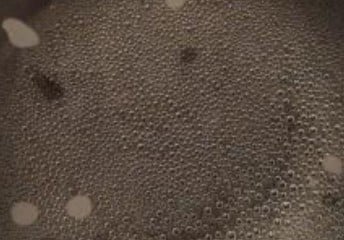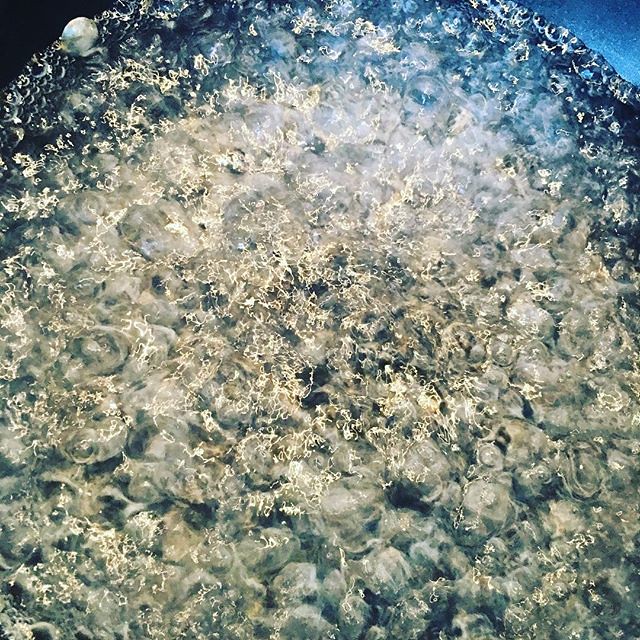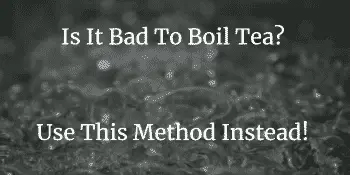Previously I boiled the kettle, dumped a low-grade teabag in a cup, and doused it with the boiled water! Since toddlerhood
Is it bad to boil Tea? For most tea, yes. Boiling has a marked effect on the taste and benefits tea provides. Boiling changes oxygen levels too which is also an important factor. Most low-grade tea is fine to boil, but green, white, Oolong and others yield greater benefits at lower temperatures. So here’s what you should do.
The Benefit of Boiling Water
Unfortunately, there’s one benefit to boiling your water which, if you follow the guidelines below you will actually lose. That is that boiling water kills larger amounts of harmful bacteria. Remember your mother telling you to boil the water first so it becomes more ‘sterilized’ well, that is true. And is good advice. The problem comes when using it with your favorite loose-leaf tea.
However, this is from a time way, way back, before water purification plants and piping got better at providing most of us with virtually clean water to start with.
Of course, there are other arguments afoot now about how much fluoride and other
So for the purposes of this, let’s just assume that most water you’re likely to use for cooking and drinking purposes is mostly healthy to start with.
Another benefit of adding boiling water is the release of flavor in the form of tannins. This is what darkens the tea and favors it whilst steeping. Over-steeping the tea can cause too much tannin to be released creating an overly bitter taste.
What Happens to Boiled Water
As the temperature in the water rises, you would think that the splashing around of water would aerate the H2O particles, allowing more air to get in would surely benefit the water in providing it with greater levels of oxygen.
Well, it seems not, actually, oxygen is released along with nitrogen and reduces further the hotter it gets. The kind of deoxygenates the water. Tea prefers oxygen to enhance aroma and flavor.
The graph below demonstrates two points:-
- The gradual reduction in oxygen levels is based on the rising temperature.
- Where in that process, approximately, the main types of tea are situated in terms of best steeping temperature.
Oxygen Levels vs Temperature. With Tea Type.
One of the main things that strike me about this graph is that most tea types are positioned toward the uppermost area of the scale – towards the boiling point. This being the optimum level, you can see then how even minor variations can seemingly make a difference.
Why Does Boiling Water Release Oxygen
I’m no scientist! But as I understand it, rather than aerating the water to increase oxygen as one might expect. Boiling water actually releases oxygen and hydrogen molecules together. Up to and at boiling point evaporation is occurring in the water. This means that oxygen and hydrogen molecules are escaping. The water vapor effectively takes the oxygen with it.
We can see this more closely in the experiment undertaken below. Where, using electrolysis, Oxygen, and Hydrogen molecules are separated out from the water.
How Does Boiling Water Affect My Tea
Boiling tea affects the level of tannins released which provide the flavor and bitterness. Also, flash burning loose leaf tea isn;t going to encourage it to yield flavor quite as easily. However, with black tea and Pu-erh – particularly half and full baked Pu-erh, it’s quite normal to boil the tea fully.
In Mongolia and Tibet, brick Pu-erh is boiled to make butter tea. Whilst Indian Chai tea is boiled in milk. So, sometimes, its right to boil tea.
Tannins are not to be confused with tannic acid. There is no tannic acid in tea. The tannins in tea are mostly polyphenols that provide antioxidants and goodness. Tannins also give the tea its color, the more tannins are released, the darker the tea. But there is a point at which the bitterness of the tannins can become too overbearing, leading to a bitter tea.
What Temperature Should I Steep Tea At?
Depending on the type of tea, there are thousands of different teas out there and steeping time depends on how tea performs best at known temperatures.
The table below provides a guide on the correct water temperature, the quantity of tea to use, and the ideal steeping time for achieving the best cup of tea.
Use This Method to Tell Water Temperature?
Aside from the initial stage of boiling water, in which the water is just getting started with heating. There are 5 main stages that ancient Chinese used to determine water temperature and whether it’s right for tea making.
It might seem a small detail, but it does have an effect on tea flavor. So we’ll go through these stages in brief and look at alternative ways of gauging water temperature.
The 5 Different Stages of Boiling Water
These might seem like unusual ways to gauge water temperature. But we have to remember these techniques were developed way back in ancient China. There were no scientific methods of measurement back then.
People could only relate (and pass down the knowledge) in a visual sense. So the names were based on the size of the eyes. Namely, sea creatures’ eye sizes, as this is what most people of the time would have been familiar with.
Stage 1 – Shrimp Eyes

At this
Stage 2 – Crab Eyes

Getting slightly larger air pockets now and steam will begin to rise from the pan. By this stage, the water will be around 175°F (79°C) and oxygen levels are at around ⅕ of what they started out at. Ideal for most white, green, and some oolong teas.
Stage 3 – Fish Eyes
Getting larger still and into the size of fish eyes, I imagine this was the size of fish you’d ideally need two hands to hold as they can be quite large.
Lots more steam and at this point the sound will become strangely calmer. The temperature here is around 180°F (82°C) and the oxygen content has dropped to around 1/7th of its starting point. Ideal for most standard, and hardier Teas White, Green, Oolong, and Darjeeling.
Stage 4 – Rope of Pearls
The covering of the pan or kettle is a mass of bubbles at this point, you will be able to sense it’s the point just before boiling as the bubbles will be in streams leading up to the top.
Stage 5 – Raging Torrent

Violently bubbling, scalding hot to the touch (of course) and almost fighting to get higher. Oxygen levels have all but disappeared. Temperature is now 212°F (100°C).
Ideally, you do not want to pour this on any loose leaf teas. Even Tisanes should be steeped before we get to this point. If you like Builders Tea, then you’re in the right place. This is Tea Bag Territory, pouring water on a teabag now would instantly begin to release the tannins and steep times would be minimal. There are no delicate flavors and nuances to ruin!
So, let’s add all those observations and their relative temperatures to our water temperature vs oxygen levels chart and see how they match up to types of tea and their recommended steeping temperature.

There are of course easier ways to measure water temperature, you can simply use a thermometer. This will give you a more accurate measure.
The alternative, if you really want to get the right temperature, is to use a temperature-controlled kettle. One I’m fond of is This one from Amazon. It’s a good price, only costing around $59 the last time I looked.

The benefit is you can see where the water is at very easily, it looks classy and has a keep-warm function which means you can avoid re-boiling the kettle altogether. It also has auto shut-off and boil-dry protection. You’d usually struggle to get all these for the price.
In Conclusion Then
Whether you let water boil depends on how much of an
Knowing the ‘Fish-eye’ method is a handy way to get as near a gauge as possible if you don’t have any other temperature measuring means available.
If you drink dust-filled tea bags, then I guess you just may not care anyway!
I hope this has been useful for those looking to visually gauge water temperature and particularly if you’re using that as a guide for tea. Maybe you can impress your friends with this knowledge next time they see you staring at the kettle whilst making them an Oolong! …now THAT’s cultured!

-13747.jpg?size=696X905)